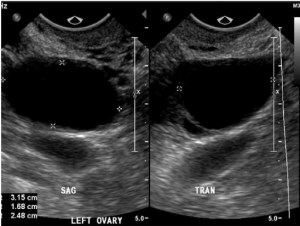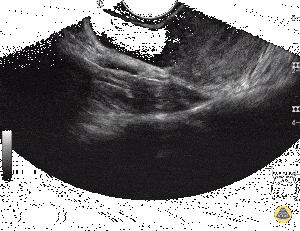Ovarian cyst
Background
- Most common are functional or follicular cysts
- Less common include PCOS, cystadenomas, and dermoid cysts
- Cysts are generally >1cm in size
- Cysts are at risk of torsion when >4cm
- Cysts <2cm are virtually risk free from torsion
Clinical Features
- Most tend to be asymptomatic
- Can cause:
- Dull pelvic pain or fullness; they can be significantly painful if ruptured
- Dyspareunia
- Pressure on the bladder
- If there is bleeding into the cyst and it ruptures, it can be life threatening, with signs of peritonitis, shock
Differential Diagnosis
RLQ Pain
- Appendicitis
- Abdominal aortic aneurysm
- Crohn's disease (terminal ileitis)
- Diverticulitis (cecal, Asian patients)
- Ectopic
- Endometriosis
- Epiploic appendagitis
- Herpes zoster
- Inguinal hernia
- Ischemic colitis
- Kidney stone
- Meckel's diverticulum
- Mesenteric lymphadenitis
- Mittelschmerz
- Neutropenic enterocolitis (typhlitis)
- Ovarian cyst
- Ovarian torsion
- PID
- Pyelonephritis
- Psoas abscess
- Testicular torsion
LLQ Pain
- Diverticulitis
- Kidney stone
- UTI
- Pyelonephritis
- Ectopic Pregnancy
- Infectious colitis
- Inflammatory bowel disease (Crohn's Disease, Ulcerative Colitis)
- Inguinal Hernia
- Mesenteric Ischemia
- Epiploic appendagitis
- Mittelschmerz
- Ovarian cyst
- Ovarian torsion
- PID
- Psoas abscess
- Testicular torsion
- Appendicitis
- Abdominal aortic aneurysm
- Herpes zoster
- Endometriosis
- Colon cancer
- Irritable bowel syndrome
- Small bowel obstruction
Evaluation
Workup
- CBC, chemistry
- UA, urine pregnancy
- Pelvic ultrasound
- Consider CT A/P to rule out other etiologies (e.g. appendicitis)
Diagnosis

Ultrasound demonstrates a simple ovarian cyst greater than 3 cm in size consistent with a follicular cyst.

Transvaginal ultrasound showing ovarian cyst[1]
- Typically diagnosed on ultrasound, with same side of pain and absence of other concerning etiologies (e.g. negative UA, not pregnant)
- Check hemoglobin level to assess for blood loss
Management
Disposition
- Home, unlessed ruptured with concern for significant blood loss
- Follow up with OBGyn
See Also
External Links
References
- http://www.thepocusatlas.com/obgyn/
- Cochrane Database Syst Rev 2011. Sep 7;(9):CD006134.
This article is issued from
Wikem.
The text is licensed under Creative
Commons - Attribution - Sharealike.
Additional terms may apply for the media files.